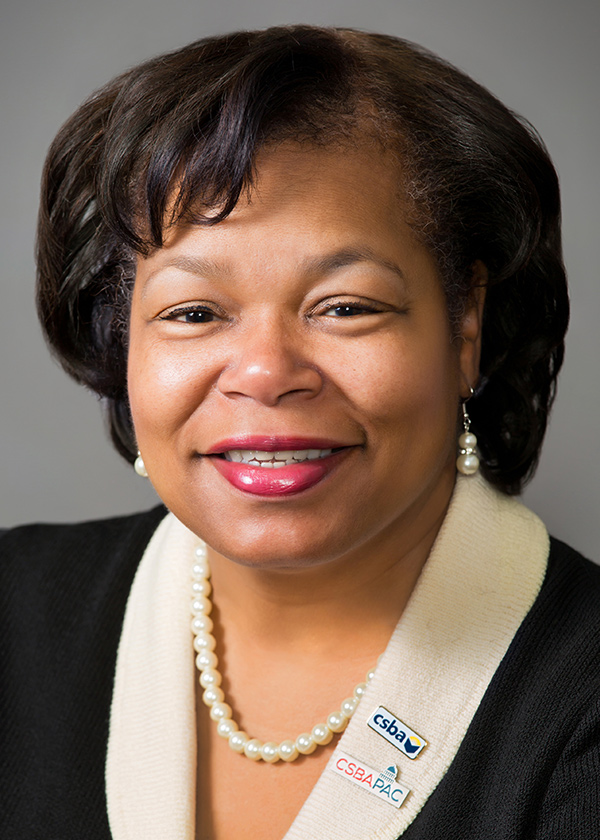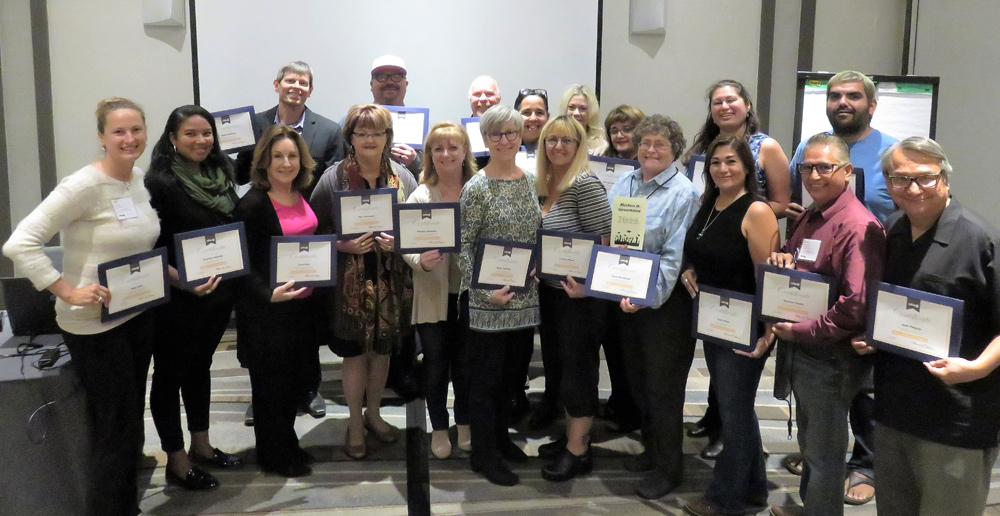

- Visit www.csba.org/Newsroom for links to digital versions of current and past issues of California School News.


Troy Flint | tflint@csba.org
Managing Editor:
Kimberly Sellery | ksellery@csba.org
Marketing Director:
Serina Pruitt | spruitt@csba.org
Staff Writers and Contributors:
Hugh Biggar | hbiggar@csba.org
Aaron Davis | adavis@csba.org
Mike Ambrose | mambrose@csba.org
Andrew Cummins | acummins@csba.org
Graphic Design Manager:
Kerry Macklin | kmacklin@csba.org
Senior Graphic Designer:
Carmen Rodriguez | crodriguez@csba.org
Emma Turner | La Mesa-Spring Valley SD
President-elect:
Xilonin Cruz-Gonzalez | Azusa USD
Vice President:
Tamara Otero | Cajon Valley Union USD
Immediate Past President:
Mike Walsh | Butte COE
CEO & Executive Director:
Vernon M. Billy
News and feature items submitted for publication are edited for style and space as necessary.


The concept of justice formed the bedrock of my career as a member of the Judge Advocate General’s Corps, commonly known as the JAG Corps, in the United States Navy. Justice will also be the north star of my tenure as CSBA president. And let me be clear — there is no justice until we succeed in closing the funding, opportunity, access and achievement gaps that prevent too many of our students from accessing a high-quality education.
Duhigg — an award-winning journalist and author of the bestselling book The Power of Habit: Why We Do What We Do in Life and Business — illustrated his point by telling the story of a Qantas Airways pilot whose passenger plane suddenly went haywire in midair.
“We’re really in the assistance business, not the punishment business,” SBE President Michael Kirst said in introducing a presentation highlighting the System of Support’s “no wrong door approach” for LEAs. As districts and county offices of education transition into the system centered on local control, decision making and cooperation, a Sacramento-area school district’s leaders provided an example of the system in action.
San Juan Unified School District Superintendent Kent Kern, board of trustees President Pam Costa and San Juan Teachers Association Executive Director Shannan Brown discussed their collaborative efforts to improve three areas in which the district was identified for differentiated assistance: Student achievement, engagement and school climate.
“I think we’ve come a long way as a district and a state,” said Costa, looking back on her career as a teacher, principal and now a board president. She said the advent of the Local Control and Accountability Plan has allowed unprecedented cooperation across many levels, including labor partners, school site teams, district leaders, the county office of education and the state. Prior to the LCAP, Kern agreed, there was often a lack of a unified approach, which led to fragmented results.
Additionally, Kern said, a move away from punitive intervention triggered by poor district performance allows leaders to focus on assisting students and root causes, rather than simply trying to improve numbers and data. “I don’t want to fix the numbers, I want to fix the issues,” he said in discussing the district’s effort to address high suspension rates for African-American students and foster youth.
Tom Armelino, executive director of the California Collaborative for Educational Excellence — an important System of Support resource, also spoke at the meeting. Armelino, (who explained the role of his relatively young agency in the fall issue of California Schools magazine) said the framework of the CCEE is first to support and prepare county offices of education to assist in-need districts and schools. The goal, he said, is not for the CCEE to fix every school in the state, but to provide resources illustrating best practices.
“This can become a very powerful system,” said SBE member Sue Burr, who also serves as chair of the CCEE board.
“Our interaction with board members indicates that boards are eager to embrace family engagement, not just as a compliance issue but as a critical lever to strengthen schools and improve student achievement. For this reason, helping boards encourage authentic family and community engagement in the LCAP process has been an important focus of CSBA’s work since the inception of LCFF,” said CSBA Director of Policy & Programs Julie Maxwell-Jolly. “We understand that a key board member role is to represent and communicate with the parents and families in their communities, so our briefs often include questions that help board members understand and include the perspectives of parents and families in their decisions about a whole range of topics we address.”

Bryan DeBlonk, Political Director, CSBA;
Roger Ruvalcaba, Assistant Superintendent, Imperial USD;
John Shook, Board Member, Savanna ESD;
Veronica Peña, Board Member, Rosemead School District;
Anne Silavs, Superintendent, Cypress ESD;
Irma Sanchez, Executive Assistant, Ontario-Montclair SD;
Sarah Galvez, Board Member, Ontario-Montclair SD;
Carlos Fierros, Board Member, Patterson Joint USD
Kelly Kent, Board Member Culver City USD;
Summer McBride, Board Member, Culver City USD;
Carol Cole, Chief Business Officer, Romoland ESD;
Pam Thompson, Board Member, Santa Paula USD;
Pamela Jacobsen, Delegate, Region 12B, Standard ESD;
Betsy Hamilton, Superintendent, Lawndale ESD;
Carolyn Bauer, Board President, Oak Grove ESD;
Sarah Bradshaw, PACER, CSBA;
Elvia Rivas, Board President, Ontario-Montclair SD;
John Palacio, Delegate, Region 15, Santa Ana USD
Not pictured but completed the program in Anaheim:
Armond Aghakhanian, Board Member, Burbank USD;
Todd Evangelist, Board Member, Central Union HSD;
Alfonso Hernandez, Board President, Palo Verde USD;
James O’Neill, Board President, Redlands USD;
Maribel Mattox, Assistant Superintendent, Moreno Valley USD;
Ron Zufall, Board President, Shasta Union HSD
At present, there are more than 5,000 school board trustees in California, serving at both the district and county office of education level. They represent the largest group of elected officials in California, hold a pivotal role in the state’s success and shape its future by aiding in the establishment of education standards and benchmarks, and by providing important oversight at the local level.
In addition to overseeing educational quality at school districts and county boards of education, trustees also take on leadership responsibilities away from the classroom. This includes decision-making and direction on budgets, responding to natural disasters, staffing, facilities upkeep and development, food services for kindergarteners through high schoolers, sports programs and other issues. Such concerns are discussed at board meetings that often run late into the night, with intense feedback from the community and scrutiny from the media. Meanwhile, many trustees — 41 percent, according to a recent California School Boards Associations survey — have an additional full-time job. Serving as a school board member is not a relaxing hobby or an easy pastime, it’s a labor of love for those who see schools as the cornerstone of our society’s future.
Recognizing the importance of this work and the need to advocate more effectively for public schools, a group of trustees established the California School Trustees Association in 1931 to “secure equal educational opportunities for the pupils in all school districts in the state.” In 1940, the Association’s founding member, Florence Porter, was instrumental in forming the National Council of State School Boards Association (later the National School Boards Association).
In 1953, California School Trustees Association rebranded as the California School Boards Association, an organization dedicated to strengthening and promoting school board governance and driving the public education policy agenda through advocacy, training and member services. This advocacy extends to the national level as well, with CSBA member and Past President Frank Pugh — a long-time trustee with Santa Rosa City Schools — now serving as the president of the National School Boards Association.
CSBA is committed to the idea that strong local boards of education are needed to provide a high-quality education for each student in each community. Since the organization’s founding, CSBA has supported boards in this work by fighting to preserve the crucial principle of local control and to secure Full and Fair Funding for California’s public schools.
In appreciation of the important role school board members play in shaping the education landscape of California, here’s to the hard-working trustees during January’s School Board Recognition Month.

The Dashboard, first released in spring 2017 as the successor to the much-maligned Academic Performance Index, aims to assess students by going beyond test scores, providing parents with a fuller picture of student performance across the state by including measures such as graduation rates, suspension rates, attendance rates and college/career readiness benchmarks.
Josh Daniels, CCEE director heading the initiative, said in his presentation that the timeline calls for an initial professional learning network to begin its work in late April or early May 2019 after a March nomination process. An additional five networks would launch in 2020-21.
Daniels said the key focuses for the CCEE during the process will be learning best practices and determining how to scale those to a statewide level, and finding effective methods to measure community engagement through the professional learning networks. “It’s more than just attendance at meeting,” he said.
The learning networks will be comprised of staff and leadership from the district, from school sites within districts and from the county office of education that oversees the district; as well as students, families and community members.
CCEE board Vice-Chair Tim Sbranti applauded staff for including school site personnel in the networks, as he said efforts sometimes focus on higher administrative levels but leave out principals, other administrators and teachers working with students day in and day out. Similarly, board Chair Sue Burr said her time as a member of the State Board of Education has proven how valuable the student perspective can be.
Representatives from the three lead partner agencies — the San Bernardino County Superintendent of Schools office, the California Association for Bilingual Education and Families In Schools — also attended the meeting and outlined their work in engaging community members, particularly those who have historically not been connected with their schools, district or county office of education.

2019 Institute for New and First-Term Board Members
MIG Courses 1 and 2
2019 Institute for New and First-Term Board Members
Board Presidents Workshop
Masters in Governance Courses 3 and 4
Masters in Governance Courses 1 and 2
CCBE County Board Governance Workshop
Masters in Governance Courses 1 and 2
Legislative Action Day
Masters in Governance Courses 3 and 4
Masters in Governance Course 5







